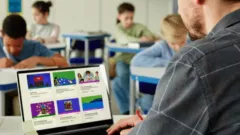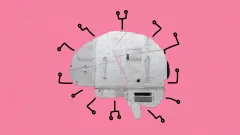Showing 40 results
July 7, 2014
Great for the imagination.
Minecraft is a unique "game." Yes, it takes time to do anything with it because it asks the users to build. To use their imagination to create their own world. This adds a sense of pride that students don't always get with other options. If you are going to use Minecraft in the classroom it is best to have clear expectations of what the finished project should be because the possibilities are endless and students can get lost in their creation.
Continue reading
March 6, 2014
Most Loved Game at School
It's the best game right now. That being said, it is a game. You can make it educational, but you have to limit the students and give them specific rules and tasks.
Continue reading
February 26, 2014
Love the creativity evoked in students in my classroom
Limited use in my classroom thus far as a project tool. I like the freedom it provides students to create in their own image and to translate their ideas into an image or scene. If it had more freedom and choices, I would assign it for our Biome project, where kids must create a diorama that represents one of the major earth biomes. Unfortunately they need to be able to put in animals and specific types of plants.
Continue reading
February 25, 2014
Be ready to get lost in another world
Minecraft is a virtual world where users can decide what type of world they want to create. Participants use various tools to create buildings, signs, landscapes, etc. Minecraft even has an educational version now that has a library of worlds, levels and activities that support a variety of subjects and allow teachers a bit more ease of use to deliver content in this virtual environment.
Continue reading
February 22, 2014
strategy based game for students that allows various levels of participation.
Great for the creative mind. Students may choose to participate in a creative mode where nothing comes to "get them" or in a survival mode. Great scaffolding option. Motivation is chosen not assumed. Creativity is endless. Resources that are attached are endless. Videos, tutorials, music... engagement is very high!!!
Continue reading
February 18, 2014
Powerful when framed correctly
Minecraft has a lot of potential and is amazing as far as video games go. You as a teacher need to have a deep understanding of the game, which is why I say set up is more than 15 minutes, you should play it for a good hour or two before deciding to hand it over to students. As an example, you'll want to go with "creative" mode or turn difficulty to "peaceful" so that student don't get caught up fighting mobs and "creepers". If you focus on building things, the social aspect of the game, and add in some educational goals, it can be a great experience.
Continue reading
February 14, 2014
A Fun open world simulation that allows Free Movement, thinking, building, survival, and exploration
I Was a negative fan of Minecraft for a long time. When it was in initial beta I despised the fact that people were having "Fun" on such a low tech game and "wasting" Their life away in a virtual world doing "nothing". Since those Times I have come full circle and made quite the oppostie appeal to the Game. Minecraft is one of those games that allows people to change their environment and atmosphere, have a totally open world experience, explore a randomly generated world, and build equipment, shelter, tools, hunt food, etc. Minecraft had gone from something that was just a "Game" to being an indepth and immersive world that you can teach and train students from all Grade levels (2+).
Continue reading
August 6, 2013
Only limited by your student's imagination!
It does take some time to setup a sever (If you plan on allowing students to access their work from home). If not setup happens in less than 5 minutes. The students will be the teachers! My students were experts in Minecraft long before I began to use it. So they have taught me a over the past few weeks.
Continue reading
August 6, 2013
Minecraft lends itself to individualized goal setting for a student and allows them to build and create, which requires higher level thinking skills.
My 8 year old daughter loves to play Minecraft. She likes it because she gets to build and create worlds and structures and she, in essence, gets to set her own goals on what she will accomplish next. My take - I didn't think it was educational until I watched her play it!
Continue reading
March 8, 2013
Open-ended world building environment has many classroom uses.
Minecraft is unusual as a game because it does not have a specific goal that must be reached.
It is often described as a "sandbox environment".
The game involves creating and using various types of blocks that represent various materials such as dirt, sand, and water in either single user or multi-user mode.
A Minecraft world is created from a "seed"-- a string of keyboard characters that results in a unique world.
In the world are all the basic blocks which can be combined on the character's crafting table to create everything from ladders to cakes.
These in turn can be combined to create villages, gardens, even simple computers.
In addition, players can play in various user modes from "peaceful" in which players never get hungry and there are no monsters to "hard" in which there are many monsters and survival is a constant concern.
There are many resources for learning to play the game:
over 10 million videos on YouTube, a Minecraft Wiki, various forums, and even a Minecraft site especially for educators (http://minecraftedu.com/).
Minecraft also offers plenty of opportunities for learning other than by playing the game.
Students learning computer programming can create "mods" that change the way the game plays or adds new things to the gaming environment.
Students can also use graphic design programs to create their own "skins" (what their character looks like) and their own "texture packs" (changing the look of the entire game).
Many students have also created videos showing how to accomplish various tasks in Minecraft.
Many first time users will be surprised to discover that the game is in fairly low resolution, blocky graphics.
This simplicity hides the much greater complexity of a three dimensional world where students can create everything from models of famous buildings to treasure hunts for other players.
Continue reading
2 people found this helpful.





